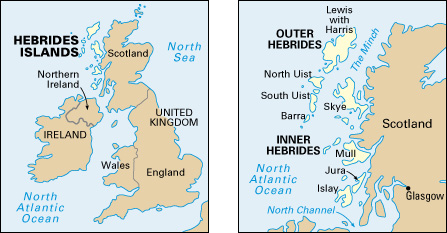Hebrides << HEHB rih `deez` >> are a group of Scottish islands that lie northwest of the mainland of Scotland. The Hebrides consist of about 500 islands and have an area of about 2,600 square miles (6,730 square kilometers). The largest islands are (1) Lewis with Harris and (2) Skye. Many of the islands are tiny and uninhabited.

The Hebrides are divided into two groups of islands, the Inner Hebrides and the Outer Hebrides, also called the Western Isles. The Inner Hebrides, which lie closest to the mainland, feature spectacular mountain scenery. The Cuillin Hills, on Skye, are especially noted for their rugged beauty. The islands of the Outer Hebrides have large areas of barren, rolling wasteland called moors. The Hebrides have a windy, humid climate.
About 18,000 people live in the Inner Hebrides and about 26,000 in the Outer Hebrides. Many of the people rent small farms called crofts and grow such crops as barley, oats, and potatoes. Other economic activities include fishing, tourism, weaving, and the distilling of Scotch whisky. Harris Tweed, a famous brand of wool cloth, is made exclusively in the Outer Hebrides.
People have lived in the Hebrides since prehistoric times. Norway took control of the Hebrides in the late 800’s and ruled them until 1266, when Scotland gained possession of the islands. Many songs and legends have been written about the Hebrides.
